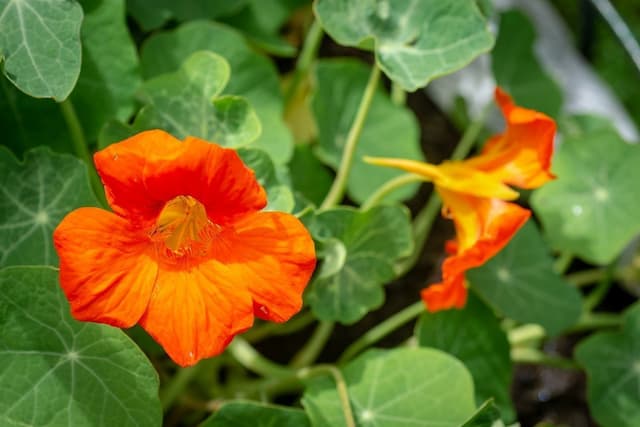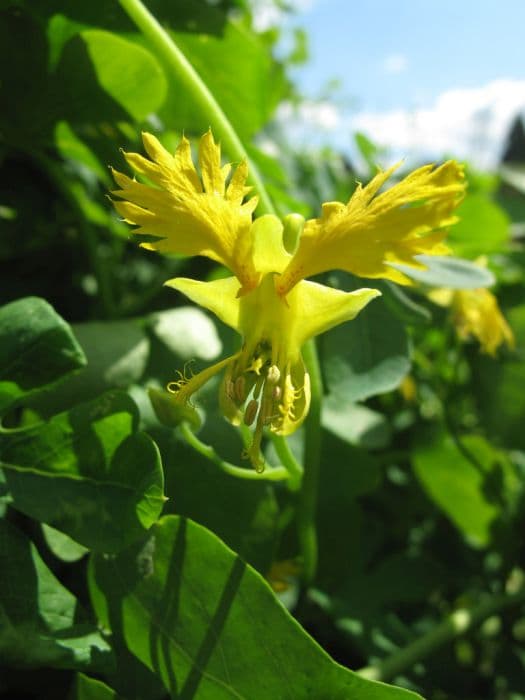Nasturtium Tropaeolum majus Alaska Series (v)

ABOUT
Tropaeolum majus Alaska Series, commonly known as Nasturtium, is notable for its vibrant and showy flowers that can range in color from yellow to orange, and deep red, often with a splash of contrasting color in the center, creating a bold and striking appearance. The petals are soft and rounded with slight undulations, contributing to a delicate appearance. These blossoms are typically set against a backdrop of unique variegated foliage; the leaves are rounded, resembling a shield or lily pad, with cream or white marbling against a deep green base. The variegation on the leaves adds a decorative touch even when the plant is not in bloom. The foliage and flowers emerge on long stalks that tend to sprawl or trail gracefully, lending a cottage garden feel to the plant's overall look. Nasturtium is also known for its peppery-tasting edible flowers and leaves, which are a popular addition to salads.
About this plant
 Names
NamesFamily
Tropaeolaceae
Synonyms
Garden Nasturtium, Indian Cress, Monks Cress
Common names
Tropaeolum majus Alaska Series (v)
 Toxicity
ToxicityTo humans
The Tropaeolum majus Alaska Series, commonly known as Nasturtium, is generally considered safe for human consumption. In fact, the leaves and flowers are often eaten in salads and the seeds can be used as a substitute for capers. There is no widespread evidence that the Nasturtium plant is toxic to humans when ingested in normal food quantities. However, eating large amounts of any plant may cause stomach upset or discomfort due to the presence of natural compounds, so moderation is advised.
To pets
Nasturtium, or Tropaeolum majus Alaska Series, is not commonly listed as a toxic plant to pets. However, while it is not specifically known for being poisonous, individual pets might have sensitivities or allergic reactions to plants that are otherwise safe for the general pet population. If a pet ingests a large amount of Nasturtium, it may experience mild gastrointestinal upset, as would be common with the ingestion of any non-food item. It is always prudent to monitor your pets and keep an eye on their reaction to any new substance they ingest. If you have concerns or notice any unusual symptoms after your pet has ingested Nasturtium, contact your veterinarian.
 Characteristics
CharacteristicsLife cycle
Annuals
Foliage type
Deciduous
Color of leaves
Variegated
Flower color
Mixed
Height
1 foot (30 cm)
Spread
1 foot (30 cm)
Plant type
Herb
Hardiness zones
9
Native area
South America
Benefits
 General Benefits
General Benefits- Edible parts: The leaves, flowers, and young seed pods of Tropaeolum majus, commonly known as nasturtium, are all edible, adding a peppery flavor to salads and garnishes.
- Easy to grow: Nasturtiums are known for being easy to cultivate, making them ideal for beginner gardeners or those looking for low-maintenance plants.
- Attracts beneficial insects: Nasturtium attracts pollinators like bees and butterflies, which are essential for the pollination of many crops and flowers.
- Pest repellent: The plant is often used in companion planting as a natural pest deterrent, repelling certain insects like aphids and whiteflies.
- Colorful blooms: The Alaska Series is known for its variegated foliage and vibrant flowers, which can add aesthetic appeal to any garden space.
- Culinary versatility: Nasturtium flowers and leaves can be used in a variety of culinary applications, from garnishing dishes to infusing vinegars and oils.
- Container gardening: This variety is suitable for container gardening, making it a good option for those with limited garden space or who prefer to garden on patios or balconies.
 Medical Properties
Medical Properties- Antibacterial: Nasturtium has been traditionally used for its antibacterial properties, especially for minor infections and wound healing.
- Antifungal: It may also possess antifungal attributes that help in combating fungal infections.
- Antiviral: The plant contains compounds that are believed to help fight against certain viruses.
- Expectorant: Nasturtium has been used as an expectorant to help clear the respiratory passages.
- Antiscorbutic: The high vitamin C content in nasturtium has led to its use in preventing and treating scurvy.
- Diuretic: It has been taken to promote urine production and reduce fluid retention.
 Air-purifying Qualities
Air-purifying QualitiesThis plant is not specifically known for air purifying qualities.
 Other Uses
Other Uses- Nasturtiums can be used as a trap crop for aphids, luring them away from more valuable plants in the garden.
- Their vibrant flowers can be used as natural dyes for fabrics and foods, providing a range of yellow, orange, and red hues.
- Nasturtium leaves and flowers can be frozen in ice cubes to create decorative elements for drinks and punches.
- The plant's seeds can be pickled and used as a substitute for capers in various recipes.
- Nasturtium can act as a companion plant to deter pests like whiteflies from vegetables and fruits due to its strong scent.
- The bright flowers attract pollinators, which can increase the yield of fruit and vegetable plants in the garden.
- When grown in hanging baskets, nasturtiums can create a natural, living curtain for privacy on balconies or patios.
- Dried nasturtium flowers can be incorporated into potpourri mixtures for their color and subtle scent.
- Their large leaves can be used as natural serving dishes for appetizers, adding an edible and decorative touch to the presentation.
- Pressed nasturtium flowers can be used in craft projects, such as homemade greeting cards or bookmarks.
Interesting Facts
 Feng Shui
Feng ShuiThe Nasturtium is not used in Feng Shui practice.
 Zodiac Sign Compitability
Zodiac Sign CompitabilityThe Nasturtium is not used in astrology practice.
 Plant Symbolism
Plant Symbolism- Conquest and Victory: The common name "Nasturtium" (for Tropaeolum majus Alaska Series) comes from the Latin words "nasus tortus" meaning "twisted nose," referring to the effect on the nose when smelling its spicy, peppery scent. Historically, this has been associated with a sense of boldness and conquest, as the plant’s name is etymologically linked to the word "trophy" (tropaeum), originating from the Greek practice of hanging the armor and weapons of vanquished foes on a tree, or arranging them on a field to signify victory.
- Vitality and Strength: Nasturtiums are known for their vibrant colors and their hardiness. They can often thrive in conditions where other plants might struggle, symbolizing endurance, strength, and the ability to overcome obstacles.
- Energy and Creativity: The bright hues of the Nasturtium flowers represent a burst of energy and the sparks of creativity. These flowers are perfect for those who wish to inspire fresh ideas and original thought paths.
 Water
WaterNasturtiums, the common name for Tropaeolum majus Alaska Series, should be watered regularly but be careful not to overwater as they prefer soil that is moist but not soggy. During the growing season, water them thoroughly once a week with about 1 inch of water. This is equivalent to approximately 0.6 gallons per 10 square feet. Adjust the amount of water depending on weather conditions—less during rainy periods and more during dry spells. Nasturtiums in containers may require more frequent watering, potentially every few days, to prevent the soil from drying out completely.
 Light
LightNasturtiums thrive in full sun to partial shade. They perform best when they receive at least 6 to 8 hours of sunlight per day. However, in very hot climates, they will appreciate some afternoon shade to protect them from the intense heat. The ideal spot for these plants is a location that gets bright morning sun but is shielded from the harsh afternoon rays, which can sometimes cause the foliage to wilt.
 Temperature
TemperatureNasturtiums prefer temperatures between 55°F and 75°F, which makes them ideal for growing in areas with mild to warm climates. They can tolerate a minimum temperature of around 40°F, but frost can damage the plant. The maximum temperature for nasturtiums is around 85°F; above this, they may become stressed. Ensure the plants get sufficient water during periods of high heat to keep them cool.
 Pruning
PruningPruning nasturtiums can help to stimulate growth and promote bushier plants. Pinch back the tips of the plants early in the season to encourage branching. Deadheading, or removing spent flowers, will also promote more blooms. Pruning is not often necessary, but if the plants become leggy or overgrown, they can be cut back by one-third. The best time for pruning nasturtiums is in the late spring or early summer when they are actively growing.
 Cleaning
CleaningAs needed
 Soil
SoilNasturtiums, the common name for Tropaeolum majus Alaska Series, thrive in well-draining soil with a pH between 6.0 and 8.0. A mix of garden soil, peat moss, and perlite or sand provides a rich yet well-draining environment. These plants are not overly nutrient-demanding and can grow in poor soils, which can actually encourage more prolific blooming as opposed to leaf growth.
 Repotting
RepottingNasturtiums usually do not require frequent repotting as they are annuals. They can be sown directly into their final locations whether in a container or in the ground. If started indoors, repotting should occur when they outgrow their initial container, typically once before being moved outdoors.
 Humidity & Misting
Humidity & MistingNasturtiums are not particularly humidity-dependent but prefer a normal range of atmospheric moisture. They do well in outdoor conditions where the humidity reflects the typical levels of the growing environment.
 Suitable locations
Suitable locationsIndoor
Place in bright light, ensure good air circulation.
Outdoor
Full sun to partial shade, protect from strong winds.
Hardiness zone
9-11 USDA
 Life cycle
Life cycleThe common name for Tropaeolum majus Alaska Series is Nasturtium. The life cycle begins with seed germination, which occurs in spring when soil temperatures warm up, usually taking 10-14 days. Following germination, the seedlings develop into bushy plants with rounded leaves and bright, edible flowers that appear throughout the summer months. Nasturtiums are annuals, and so they will go through their entire life cycle—growing, flowering, and setting seed—in one growing season. As temperatures cool and daylight decreases in autumn, the plants complete their life cycle and die after they have produced and dropped their seeds, which may lie dormant until the following spring. Some seeds may be harvested and stored for planting the next season to ensure the continuation of the plant's life cycle.
 Propogation
PropogationPropogation time
Spring to early summer
The Tropaeolum majus Alaska Series, commonly known as Nasturtium, can be propagated by seed. The best time to sow nasturtium seeds is in the spring after the last frost has passed. The seeds are large and should be planted about 1/2 inch (approximately 1.25 cm) deep in well-draining soil. It is recommended to soak the seeds in water for about 12 to 24 hours before planting to encourage germination. Once planted, keep the soil moist until germination, which typically occurs within 10 to 14 days. Nasturtiums prefer a sunny location but will tolerate partial shade. They are not fussy about soil quality, often thriving in less fertile soils, and can benefit from occasional watering but are relatively drought-tolerant once established.



